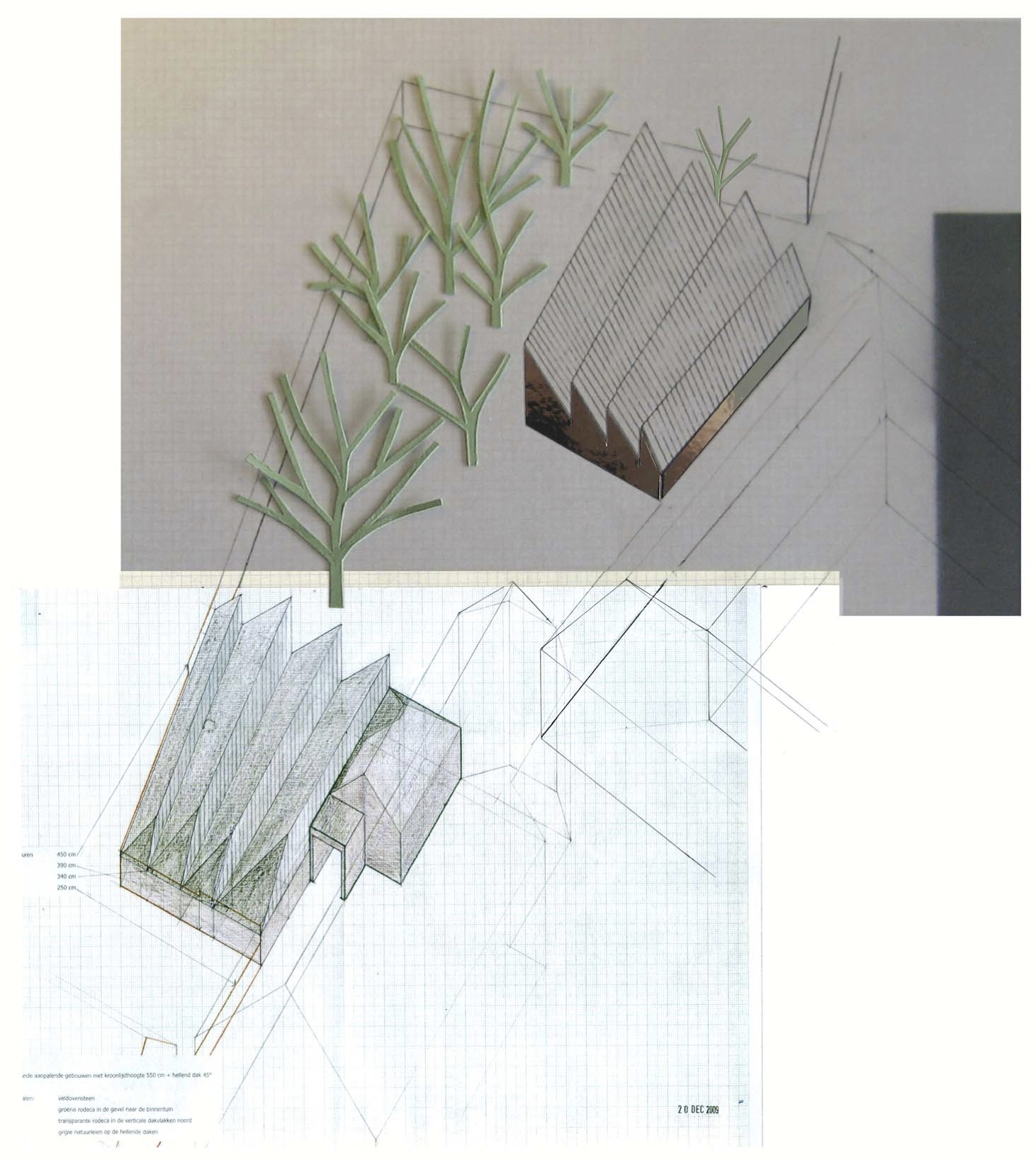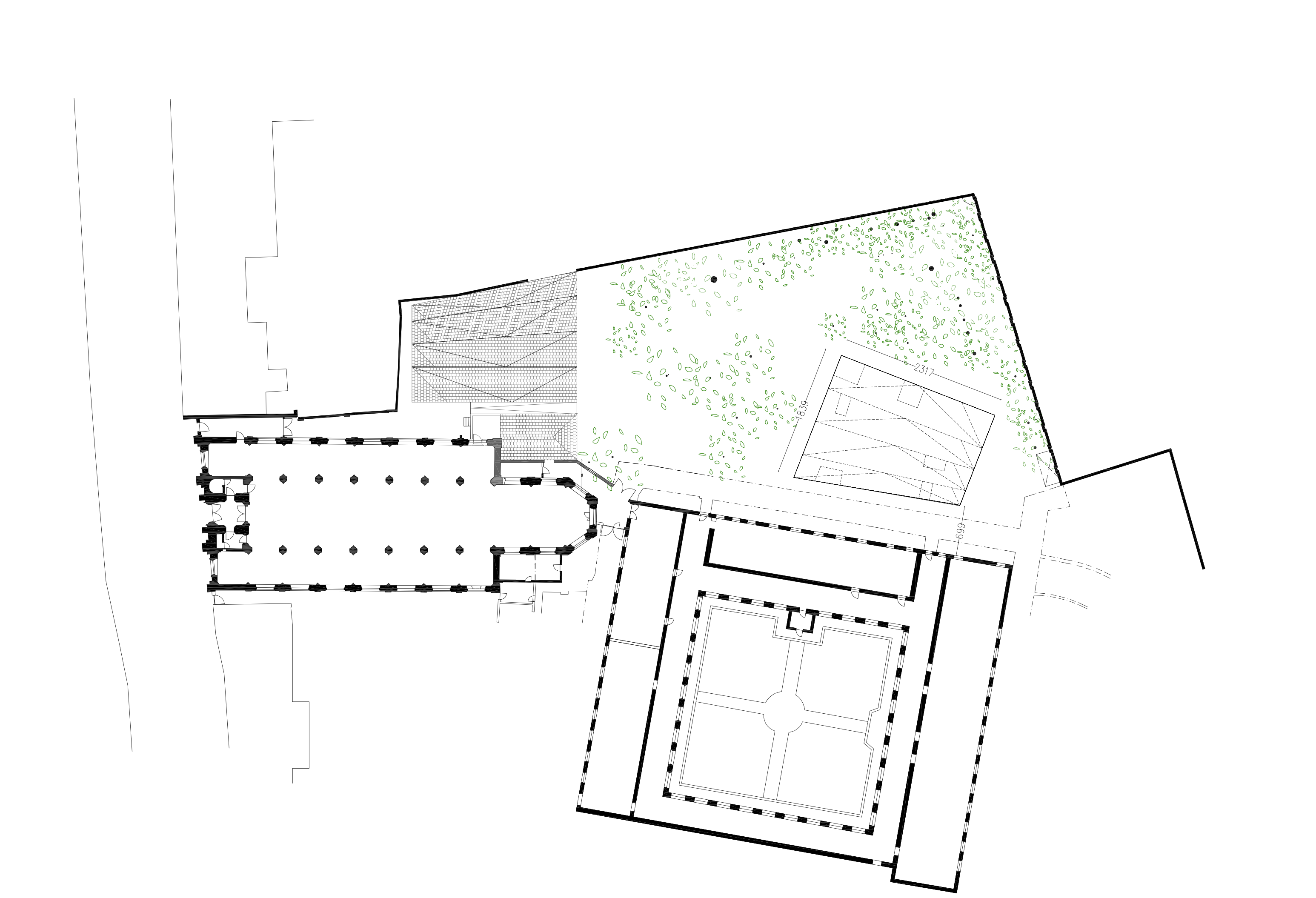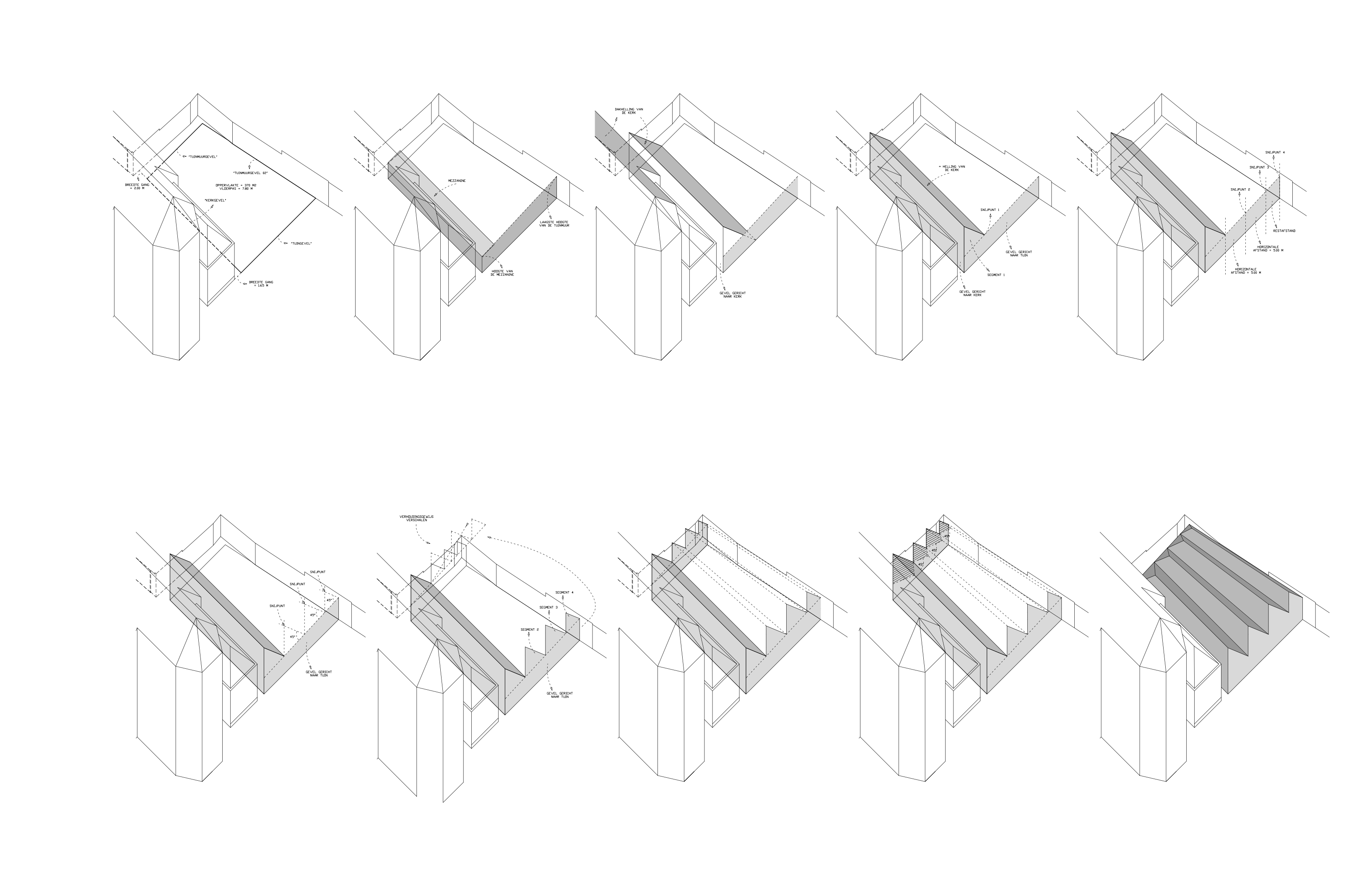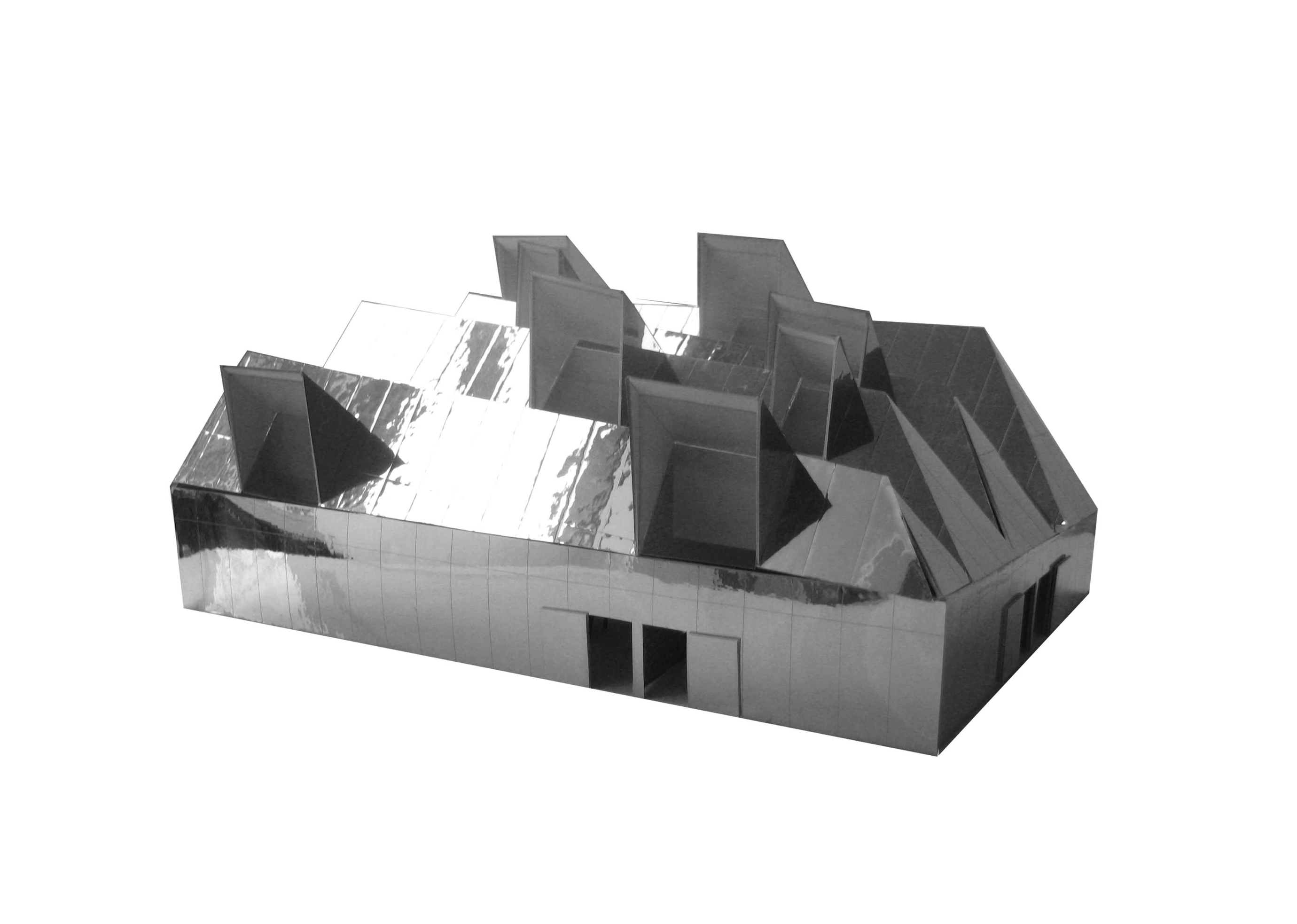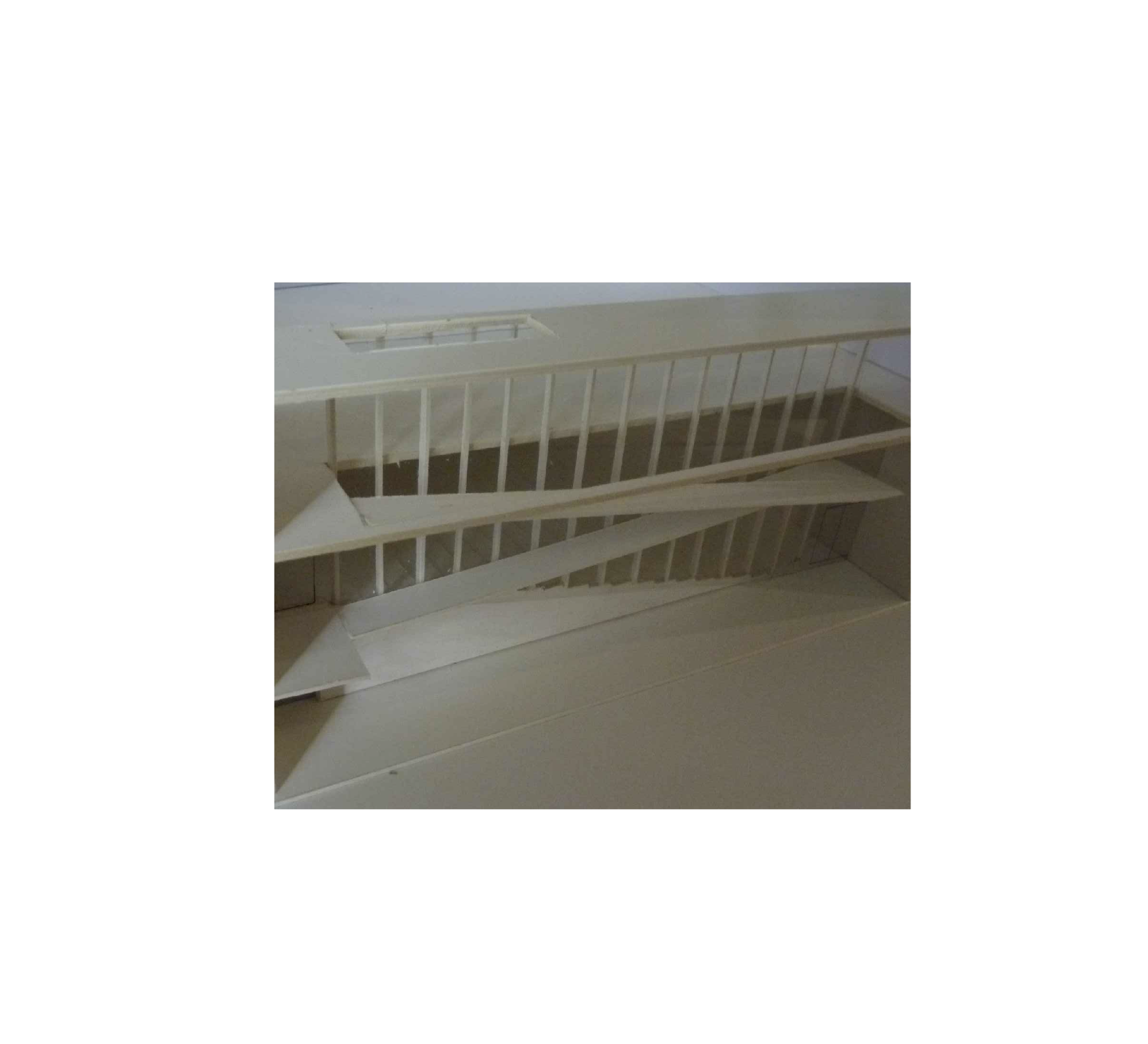In collaboration with De Vylder Vinck Tailleu
The project consists of building a multipurpose studio situated between the church and the garden.
On this site, there is currently a low, worthless structure that must be demolished to make way for the renovation of the garden wall that borders the courtyard. This building to be demolished has a single storey, covers 75 m², and is indicated on the site plan.
The layout of the existing garden wall serves as the basis for the studio’s plan and defines the shape of the ground plan. This space between the church and the garden wall will be covered with shed roofs whose slope matches that of the church and the sacristy. The slope of the church roof continues seamlessly into the slope of the first shed roof. With this slope (45°) as the first fixed parameter, and the height of the garden wall (3.9 m) as the second fixed parameter, the height of the building is determined.
From the first shed roof, the other three roofs fan out (in both height and width) to connect with the slanted position of the garden wall in relation to the church. The final shed roof is the lowest, minimising its visual impact on the surroundings. For the same reason, the ridgelines of the shed roofs are pulled back where they meet the gardens of neighbouring properties.
The timber truss structure spans the entire space, creating a column-free interior with a great sense of openness. The shed roofs admit northern light into the studio, providing ideal (northern) working light. The mass of the building is carried by light, as if gravity itself has been relinquished. The light seeps outwards beneath the structure. The backlighting places the construction in a twilight zone between structural and sacred.
The studio will be one large, open, multipurpose space, modest in design yet sensually lit by northern zenithal natural light. Beneath this large space lies an underground level.
The studio and basement are accessible via three double doors, each set on both sides of the building. These lead either to stairs (four in total) descending to the basement, or directly into the ground-floor studio. At the same time, they provide visual connections through the studio from garden to garden, or offer a view into the studio itself, establishing a direct relationship with the outdoors.
The long circulation zones around the perimeter, with their staircases, bring daylight into the underground spaces. In the church studio, light enters through the corners; in the garden studio, along the walls.
The design seeks to combine the elegance of ecclesiastical architecture with the rational clarity of simple spatial architecture. The concept is adapted as clearly and simply as possible to the specific demands of the project. Beyond being a building with a multipurpose studio function, it also serves as a link between Holstraat, the abbey, the church, the new studio, and as a shortcut between the Department of Fine Arts and the Department of Architecture.
The church studio is built in red-brown brick, the same material as the church and sacristy. The transparent elements in the three fanned-out roofs are made of Rodeca, a lightweight material with high insulation value. Windows are placed in certain parts of the façades, echoing the folded dormers of the garden studio, allowing views from the studio towards the church and its stained-glass choir windows.
The interior remains white, focused on simplicity—like a blank canvas. Polished concrete floors, metal staircases, and timber trusses for the roof, along with wooden window and door frames. Uncomplicated.
The east façade of the church studio is clad in mirrors, referencing the reflective surfaces of the garden studio. These mirrors add an extra dimension to the enclosed courtyard. We are staging a square entirely bordered by garden walls.
The studio building does not wish to be a church, a palace, or a museum; it is a contemporary site. It conceals its function from the city and its surroundings behind a unifying urban screen. It transforms historical prototypes into forms and functions that are contemporary. It encloses the site. It evokes memories. It is contemporary yet timeless. It does not proclaim its opinion, but it speaks with a self-consistent rhetorical voice.
Mirror, mirror on the school.
Little mirror before the school.
The jester’s exercise—or rather, the mirror’s exercise. As the ultimate sublimation of a new place within its surroundings. As the ultimate mentor of the arts. This is the metaphysical challenge for a “dumb” studio.
There is something about the jester—the jester as the ultimate figure who constantly redefines reality, showing what is not, revealing that reality is not truly real. Choosing “different” over “true,” and in doing so, perhaps becoming “truer.”
The jester is not an irritating or comical, short, twisted figure. Those who listen to him long and well will see in the jester an upright man, with raw wisdom on his tongue and eyes that reflect the world as you have never seen it before. The jester is insight. Insight itself. And above all: always different.
Beautiful words about the jester, aren’t they? And about mirrors, too.
But now the jester jumps into the project. And see what the jester sees—or what you see in his eyes.
The jester actually sees a beautiful project: how the studio stands against the church and tries to follow the geometry drawn between the church and the street—long, narrow fingers. How the building hides away in that green garden, nestled against the garden walls.
And how that building is truly a studio. A real studio. With northern light and a monopitch roof—the prototype as the answer to the question.
The jester saw. And saw that the jester was good.
But in the jester’s eyes—eyes that mirror the world as you have never seen it before—we see it again: that building!
Are there two buildings?
At least in the jester’s eyes. Reflected in the jester’s eyes.
And yes—behold—two buildings. Two studios.
And even more: one—the jester himself—is the mirror.
It is the mirror, the reflection of the church studio. The ultimate reflection: the point reflection.
Point. Mirror.
The second building is nothing other than the first. Except that it is point-reflected, making it completely different. And except that the second building is itself made of mirrors. Mirror to its surroundings. Surrounded by green. And into unreachable depths. Reflection of the monastery. And in the deepest recess of that reflection, a third time!
Two buildings. The same, yet different. One real. The other: differently real.
Gazing at each other, then turning away, and then—so profoundly—into each other.
No, there is no mirror. There is only environment. Everywhere.
And so, just slightly different. And therefore, perhaps entirely different. Yet in an unexpected harmony—the harmony of the image.
CREDITS
Status: Competition: laureate (not executed)
Client: Sint Lucas Hogeschool voor Architectuur (KU Leuven)
Technical studies: Bast
